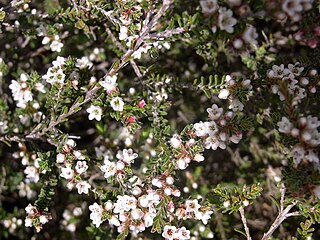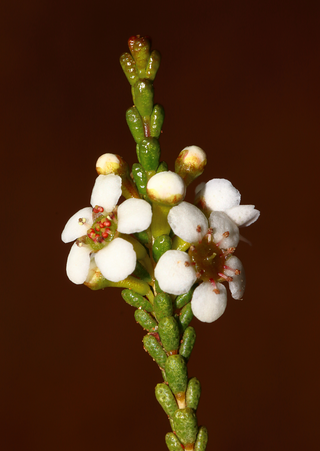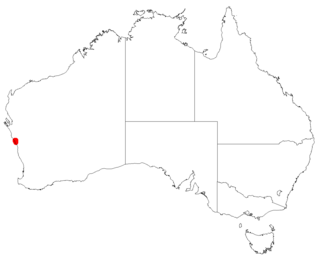
Thryptomene hexandra, commonly known as Palm Valley myrtle in the Northern Territory, is a species of flowering plant in the family Myrtaceae and is endemic to north-eastern Australia. It is an erect, much-branched shrub with linear to lance-shaped leaves and white flowers with six stamens.

Micromyrtus blakelyi is a species of flowering plant in the family Myrtaceae and is endemic to a small area near Sydney Australia. It is a low, cushion-like shrub with overlapping, keeled, linear leaves and small pink flowers arranged singly in upper leaf axils.
Baeckea latens is a species of flowering plant in the family Myrtaceae and is endemic to the south of Western Australia. It is an upright, spreading shrub with erect, linear leaves and small white flowers with three to ten stamens.
Baeckea pygmaea is a species of flowering plant in the family Myrtaceae and is endemic to the south-west of Western Australia. It is a slender and erect or spreading shrub with narrowly egg-shaped to almost linear leaves and small white flowers with 12 to 25 stamens.
Baeckea uncinella is a species of flowering plant in the family Myrtaceae and is endemic to the south coast of Western Australia. It is a shrub with narrowly egg-shaped to linear leaves and small white flowers with seven to thirteen stamens.
Micromyrtus acuta is a species of flowering plant in the myrtle family, Myrtaceae and is endemic to the southwest of Western Australia. It is an erect shrub with small, oblong leaves and small white flowers in the upper leaf axils.
Micromyrtus arenicola is a species of flowering plant in the myrtle family, Myrtaceae and is endemic to a small area in the southwest of Western Australia. It is an erect shrub with small, linear to narrowly egg-shaped leaves and small white flowers.
Micromyrtus barbata is a species of flowering plant in the family Myrtaceae and is endemic to inland areas of Western Australia. It is a shrub with small, overlapping, narrowly egg-shaped leaves and small white flowers arranged singly in upper leaf axils.
Micromyrtus chrysodema is a species of flowering plant in the myrtle family, Myrtaceae and is endemic to a small area of inland Western Australia. It is a densely branched shrub with small, narrowly oblong leaves and small white flowers.

Micromyrtus clavata is a species of flowering plant in the family Myrtaceae and is endemic to inland Western Australia. It is an erect, compact or sprawling shrub with erect, egg-shaped leaves with the narrower end towards the base and small white flowers arranged singly in upper leaf axils.
Babingtonia delicata is a species of flowering plant in the family Myrtaceae and is endemic to a small area in the southwest of Western Australia. It is a slender shrub with erect stems, linear leaves and bright pink flowers in groups of up to three, each flower with 4 to 8 stamens.
Babingtonia fascifolia is a species of flowering plant in the family Myrtaceae and is endemic to the southwest of Western Australia. It is a shrub with erect, slender stems, linear leaves and white or pale pink flowers in groups two to seven in leaf axils, each flower with 19 to 23 stamens.

Leucopogon borealis is a species of flowering plant in the heath family Ericaceae and is endemic to a restricted area of the west of Western Australia. It is an erect shrub with hairy young branchlets, linear leaves and white flowers in nine to twenty upper leaf axils.
Cryptandra inconspicua is a flowering plant in the family Rhamnaceae and is endemic to the southwest of Western Australia. It is a small, spreading shrub with narrowly elliptic to egg-shaped leaves and head-like clusters of white, tube-shaped flowers.
Cryptandra micrantha is a flowering plant in the family Rhamnaceae and is endemic to the southwest of Western Australia. It is a prostrate or upright shrub with spiny branchlets, narrowly oblong to elliptic leaves and dense clusters of white or cream-coloured, tube-shaped flowers.
Cryptandra minutifolia is a flowering plant in the family Rhamnaceae and is endemic to the south-west of Western Australia. It is a spreading shrub with oblong to elliptic leaves and clusters of white or pink, tube-shaped flowers.
Cryptandra monticola is a flowering plant in the family Rhamnaceae and is endemic to the south-west of Western Australia. It is an erect or spreading shrub with linear or narrowly oblong to elliptic leaves and head-like clusters of white, tube-shaped flowers.

Stenanthemum reissekii is a species of flowering plant in the family Rhamnaceae and is endemic to the south-west of Western Australia. It is an erect or low-lying shrub with hairy young stems, egg-shaped or narrowly egg-shaped leaves with the narrower end towards the base, and clusters of densely hairy white or cream-coloured flowers.

Pimelea spiculigera is a species of flowering plant in the family Thymelaeaceae and is endemic to Western Australia. It is an erect shrub with linear to narrowly egg-shaped leaves and heads of yellow or greenish-yellow flowers surrounded by 2 or 4 egg-shaped involucral bracts.
Brachyloma elusum is a species of flowering plant in the family Ericaceae and is endemic to a two locations in the west of Western Australia. It is an erect, compact shrub with linear to narrowly egg-shaped leaves with the narrower end toward the base, and red, tube-shaped flowers.






